Putting climate sensitivity estimates in context
What the science says...
Schmittner et al. find very low probability of both low and high equilibrium climate sensitivities. Their estimated likely range of equilibrium climate sensitivity values is only marginally lower than that of the IPCC, and their lower value is almost entirely based on a new estimate of Last Glacial Maximum (LGM) temperatures warmer than previous estimates. It remains to be seen whether this new estimate - and thus the Schmittner climate sensitivity - withstands the test of time.
Schmittner finds low climate sensitivity
"a paper...in Science magazine concludes that the climate sensitivity—how much the earth’s average temperature will rise as a result of a doubling of the atmospheric concentration of carbon dioxide—likely (that is, with a 66% probability) lies in the range 1.7°C to 2.6°C, with a median value of 2.3°C. This is a sizeable contraction and reduction from the estimates of the climate sensitivity given by the Intergovernmental Panel on Climate Change (IPCC) Fourth Assessment Report (AR4), in which the likely range is given as 2.0°C to 4.5°C, with a best estimate of 3.0°C" (Pat Michaels)
A new paper in Science from Schmittner et al. (2011) attempts to constrain climate sensitivity based on temperature reconstructions of the Last Glacial Maximum (LGM) approximately 20,000 years ago:
"combining extensive sea and land surface temperature reconstructions from the Last Glacial Maximum with climate model simulations we estimate a lower median (2.3 K) and reduced uncertainty (1.7–2.6 K 66% probability)."
This estimate is significantly narrower and a bit lower than the IPCC-estimated 66% probability range for equilibrium climate sensitivity of 2 to 4.5°C for doubled atmospheric CO2, and is illustrated in Figure 1.
Figure 1: Marginal posterior probability distributions for equilibrium climate sensitivity to doubled atmospheric CO2 (ECS2xC) from Schmittner et al. (2011), estimated from land and ocean, land only, and ocean only temperature reconstructions.
Concerns About the Study
There are some unusual aspects about this study which require further investigation before the conclusions of the study can be accepted, as the authors themselves point out. For example, the study uses a relatively new global mean surface temperature reconstruction for the LGM of just 2.2°C cooler than interglacial temperatures in the locations where they have proxy data, or 2.6°C from the global model average. This is significantly lower than most paleoclimate estimates, which generally put the LGM in the range of 4 to 7°C cooler than current temperatures. For comparison, in their study also using the LGM to constrain climate sensitivity, Hansen and Sato (2011) used a mean surface temperature change of 5°C, consistent with the body of literature (Figure 2).
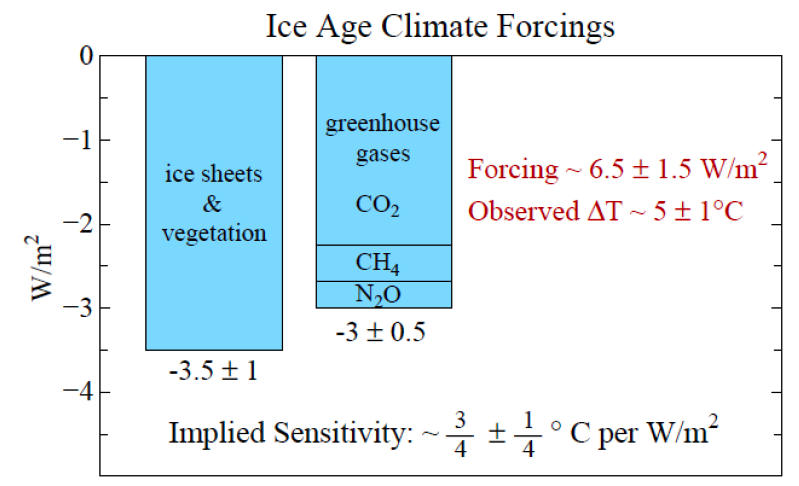
Figure 2: Climate forcings during the ice age 20 ky ago relative to the pre-industrial Holocene from Hansen and Sato (2011)
Since the radiative forcing associated with doubled CO2 is 3.7 Watts per square meter (W/m2), Hansen and Sato's result implies a fast-feedback climate sensitivity of 2.8°C, which is slightly outside the Schmittner et al. 66% probability range (at the upper end of their 90% probability range). In fact, as Urban explains, the main reason Schmittner et al. arrive at a lower climate sensitivity estimate than previous studies is due to their lower LGM temperature reconstruction:
"our LGM temperature reconstruction is quite different from what has been commonly assumed, and our study may prove inconsistent with other evidence that we have not yet considered. This is something that will have to be sorted out by further debate and research...our new temperature reconstruction explains a lot of the difference between our climate sensitivity estimate and previous estimates."
In an interview with New Scientist on this paper, Gavin Schmidt said:
"The model estimate of the cooling during the Last Glacial Maximum is a clear underestimate...A different model would give a cooler Last Glacial Maximum, and thus a larger sensitivity."
As Figure 1 shows, the Schmittner et al. global climate sensitivity estimate is dominated by the ocean data, which is based on from the Multiproxy Approach for the Reconstruction of the Glacial Ocean (MARGO) project, about which Richard Alley noted:
"MARGO made a solid effort, which indicates very small temperature changes. But, there are other ways to do it, and indeed, [Schmittner et al.] coauthor Alan Mix has published independent papers indicating that the temperature changes were larger in some regions than indicated by MARGO. David Lea and others have also obtained larger temperature shifts….
In short, the MARGO data for the ocean show very small temperature change from the ice age to today, and thus lead to the low climate sensitivity, but they disagree with some independent estimates showing larger temperature change. They also lead to disagreement with the pollen-based land temperature data. Furthermore, they lead to an answer that disagrees with many other lines of evidence for climate sensitivity."
Another concern regarding the study is in the model they used - the University of Victoria (UVic) climate model. UVic is an admittedly simple model compared to other global climate models, as co-author Nathan Urban discussed in an interview with Planet 3.0:
"UVic isn’t the most complex model either. It has a simplified atmosphere, which is an advantage and disadvantage. The disadvantage is that it has a very approximate representation of atmospheric processes. The advantage is that this makes the simulations run faster. It is less computationally expensive."
A number of other climate scientists interviewed for a BBC article also expressed reservations about the study's assumptions and results. For example, the climate sensitivity in transitioning from a cold to warm period may be different than that in transitioning from a warm to a hot period, as Andrey Ganopolski noted:
"There is evidence the relationship between CO2 and surface temperatures is likely to be different [during] very cold periods than warmer."
This is particularly true since the LGM only experienced fast feedbacks, whereas due to the rapid rate of the current climate change, slower feedbacks may be triggered on century timescales.
The authors themselves have their own concerns, as is the case with any good scientific study, and expressed a number of caveats about their findings. For example:
"Two things are immediately apparent from these [Figure 1] curves. First, the sea surface temperature data support lower climate sensitivities and the land surface temperature data support higher sensitivities. There isn’t a great deal of overlap between these curves, so this suggests a possible inconsistency between the land and ocean analyses. Second, when we combine the land and ocean data, the ocean data dominate the result (the black and blue curves are very similar), “overruling” what the land data have to say. I think this is, at least in part, because there are more ocean data than land data."
"There are many hypotheses for what’s going on here. There could be something wrong with the land data, or the ocean data. There could be something wrong with the climate model’s simulation of land temperatures, or ocean temperatures. The magnitudes of the temperatures could be biased in some way. Or, more subtly, they could be unbiased, on average, but the model and observations could disagree on the cold and warm spots are, as I alluded to earlier. Or something even more complicated could be going on.
Until the above questions are resolved, it’s premature to conclude that we have disproven high climate sensitivities, just because our statistical analysis assigns them low probabilities."
Setting these concerns aside for the moment, what would the Schmittner et al. results mean, if correct?
The Good News
The climate denialists have of course focused on the good news aspect of this paper - that it claims to rule out the 'long tail' of high climate sensitivity. Most individual studies estimating climate sensitivity are unable to rule out very high sensitivity values (Figure 3).
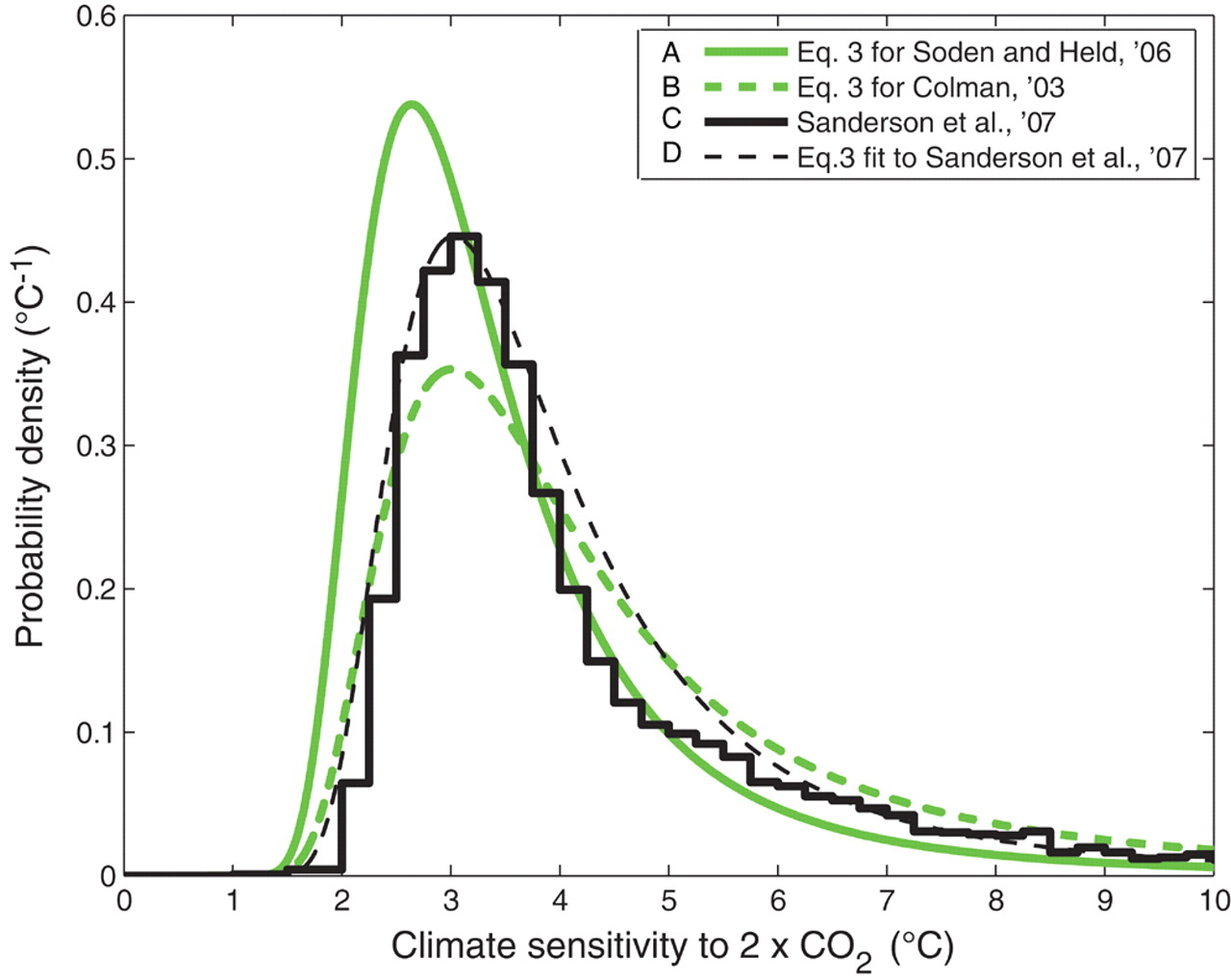
Figure 3: Probability distribution of climate sensitivity to a doubling of atmospheric CO2 (Roe & Baker 2007).
However, Annan and Hargreaves (2009) used a Bayesian statistical approach to investigate various probabilistic estimates of climate sensitivity, and concluded that
"the long fat tail that is characteristic of all recent estimates of climate sensitivity simply disappears, with an upper 95% probability limit...easily shown to lie close to 4°C, and certainly well below 6°C."
So Schmittner et al. would not be the first study to find low probability of very high values of (fast feedback) climate sensitivity. Nevertheless, their conclusion that high sensitivity models do not simulate LGM changes well is good news:
"models with ECS2xC > 4.5 K overestimate the cooling almost everywhere, particularly at low latitudes. High sensitivity models (ECS2xC > 6.3 K) show a runaway effect resulting in a completely ice-covered planet."
The Bad News
For those true skeptics among us who look at the entire study, unfortunately it contains substantial bad news. Firstly, in addition to ruling out very high equlibrium climate sensitivity values, it would also rule out very low values:
"Models with ECS2xC < 1.3 K underestimate the cooling at the LGM almost everywhere, particularly at mid latitudes and over Antarctica"
In other words, Schmittner et al. find equilibrium sensitivities of less than 1.3°C just as unrealistic as sensitivities greater than 4.5°C. The low sensitivity arguments made by the likes of Spencer, Lindzen, Christy, Monckton, etc., which are the climate denialist "endgame", proclaim that climate sensitivity is indeed less than 1.3°C for doubled CO2. According to Schmittner et al., they're wrong. Somehow the climate denialists glossed over this aspect in their reporting on the paper.
It's worth briefly noting here that when confronted with the fact that paleoclimate data are inconsistent with their asserted low climate sensitivity values, the "skeptics" suddenly find the proxy data and models unreliable. For example, Pielke Sr.:
"I do not find the glacial and interglacial periods as useful comparisons with the current climate since when we study them with models"
But once the proxy data and models support a conclusion they want to believe - climate sensitivity is not extremely high - suddenly the supposed "skeptics" (including Pielke's 'colleagues') are willing to accept the results entirely uncritically. Just another of those denialist self-contradictions to add to the list.
Secondly, as noted above, Schmittner et al. have assumed that the difference between a glacial maximum and interglacial temperature is a mere 2.6°C. The global average surface temperature has already warmed 0.8°C over the past century. During the LGM, the surface was covered with huge ice sheets, plant life was different, and sea levels were 120 meters lower. As Schmittner notes:
"Very small changes in temperature cause huge changes in certain regions, so even if we get a smaller temperature rise than we expected, the knock-on effects would still be severe."
and in a Science Daily interview:
"Hence, drastic changes over land can be expected. However, our study implies that we still have time to prevent that from happening, if we make a concerted effort to change course soon".
The Ugly News
In short, if Schmittner et al. are correct and such a small temperature change can cause such a drastic climate change, then we may be in for a rude awakening in the very near future, because their smaller glacial-interglacial difference would imply a quicker climate response a global temperature change, as illustrated in Figure 4.
Figure 4: IPCC and Schmittner et al. CO2-caused warming based on business-as-usual (BAU) emissions (defined as IPCC Scenario A2) and their equilibrium climate sensitivity best estimates, assuming transient sensitivity is ~67% of equilibrium sensitivity (solid lines) vs. their best estimates for the average global surface temperature change between the LGM and current interglacial (dashed lines).
As Figure 4 illustrates, although the Schmittner et al. best estimate for climate sensitivity results in approximately 20% less warming than the IPCC best estimate, we also achieve their estimated temperature change between glacial and interglacial periods (the dashed lines) much sooner. The dashed lines represent the temperature changes between glacial and interglacial periods in the Schmittner (blue) and IPCC (red) analyses. If Schmittner et al. are correct, we are on pace to cause a temperature change of the magnitude of an glacial-interglacial transition - and thus likely similarly dramatic climate changes - within approximately the next century.*
* - Note that this calculation and Figure 4 exclude warming caused by non-CO2 greenhouse gases (GHGs) whose warming effects are currently approximately offset by aerosols, but this offset probably won't continue in the future as GHG emissions continue to rise and aerosol emissions likely fall due to efforts to achieve clean air. Thus our CO2-caused warming estimates are likely conservative, underestimating total future global warming.
Schmittner Take-Home
To summarize,
- Schmittner et al. believe they have found low probabilities for both very high and very low equilibrium climate sensitivities, and their best-fit model sensitivity is 2.4°C for doubled CO2
- There are some concerns about the Schmittner et al. methodology, such as their use of the simple and outlying UVic climate model, and their estimate that the temperature change between interglacial periods and the LGM was just 2.6°C
- If Schmittner et al. are right about climate sensitivity and LGM temperature change, then if we continue with business-as-usual GHG emissions, we will match the amount of warming between glacial and interglacial periods within roughly the next century. Some of the differences between glacial and interglacial periods include 120 meter sea level rise, and a completely different global landscape - very dramatic climate changes.
In short, we should not over-emphasize the results of Schmittner et al., as the authors themselves warn. Their results are roughly consistent with other estimates of climate sensitivity (Figure 5).
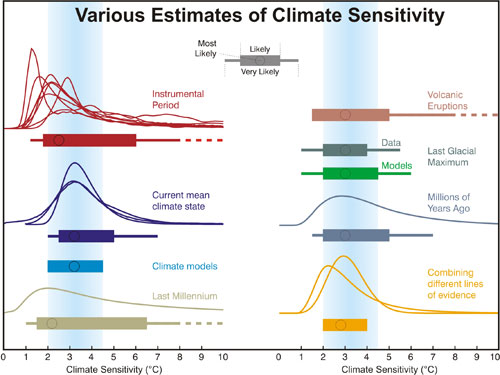
Figure 5: Distributions and ranges for climate sensitivity from different lines of evidence. The circle indicates the most likely value. The thin colored bars indicate very likely value (more than 90% probability). The thicker colored bars indicate likely values (more than 66% probability). Dashed lines indicate no robust constraint on an upper bound. The IPCC likely range (2 to 4.5°C) and most likely value (3°C) are indicated by the vertical grey bar and black line, respectively (Source: Knutti and Hegerl 2008)
In fact if Schmittner et al. are totally correct, we may be in for some rapid climate changes in the relatively near future, as we approach the amount of warming that separates a glacial from an interglacial period.
Last updated on 23 October 2016 by dana1981. View Archives































 Arguments
Arguments





















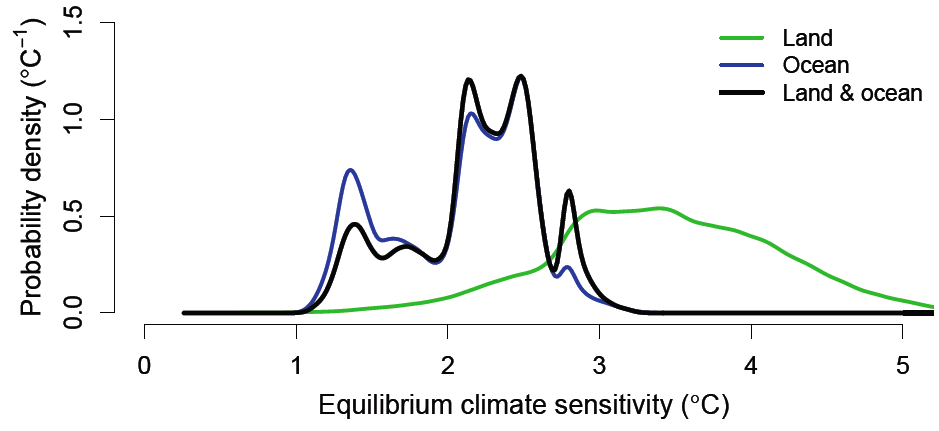
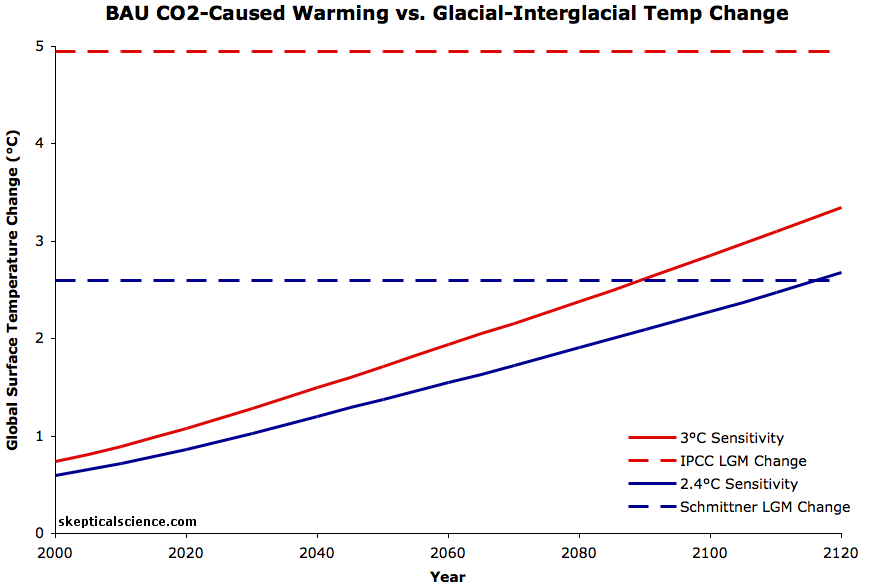







Climate Myth...